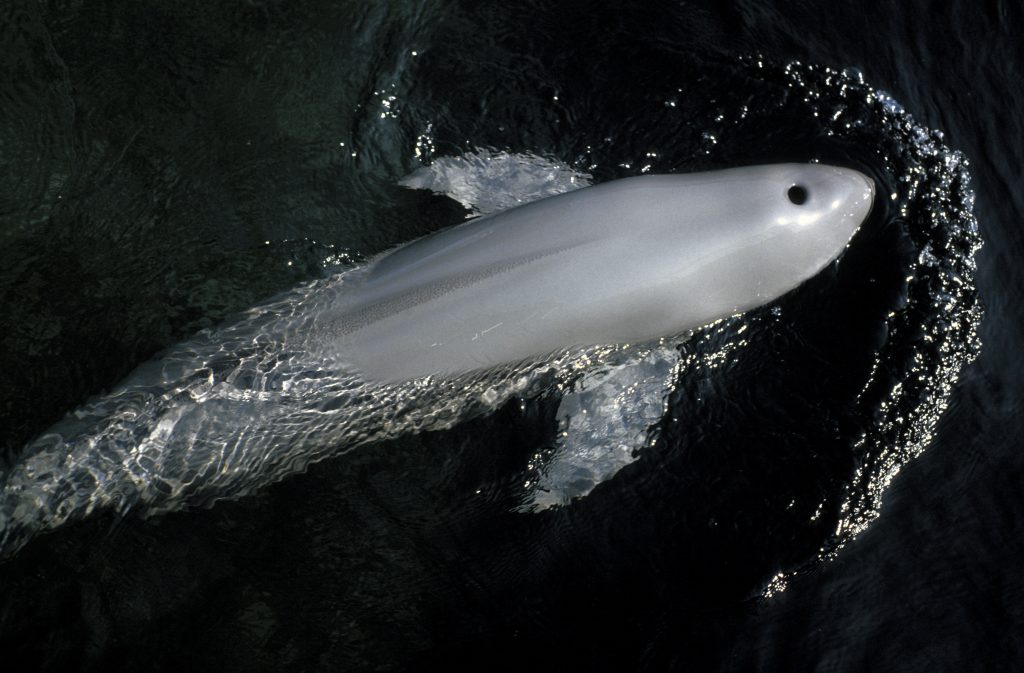Scientific Name
Neophocaena asiaeorientalis
Conservation Status (IUCN)
General Population: Endangered (high risk of extinction in the near future)
Yangtze River Population: Critically Endangered (facing a very high risk of extinction in the wild)
Interesting Facts
Only recently separated from the Indo-Pacific Finless Porpoise in taxonomic classification (2008). There are 2 subspecies of Narrow-Ridged Finless Porpoise, N.a. asiaorientalis (Yangtze River population) and N.a. sunameri (East Asian Finless Porpoise).
The Yangtze River subspecies of narrow-ridged finless porpoise shared its habitat with another cetacean, the Baiji dolphin, until the extinction of that species in 2006. Baiji was profiled in “Last Chance to See”, by Douglas Adams (author of Hitchhikers Guide to the Galaxy), before its demise.
Range
Shallow coastal waters from the Taiwan Strait to Northern China, Korea, and northern Honshu, Japan (though a single individual was found in Okinawa in 2010). The N.a. asiaeoriantalis subspecies is found only in the Yangtze River (up to 1600 km inland) and in some associated lakes and estuaries (Poyang and Dongting lakes; Gan Jiang and Xiang Jiang rivers). The range of this species has been fragmented due to human activity
Physical Description and Identifying Features
No dorsal fin, and more slender than other porpoise species, with a flexible neck. They have tubercles on its back from mid-back to tail, with a dorsal ridge anywhere from 0.2 to 1.2 cm wide.

Behavior and Ecology
Narrow-ridged finless porpoise tend to inhabit shallow waters, less than 50m deep, along coasts including estuaries, some large rivers, mangrove swamps, and shallow bays. There is a strong preference for waters with sandy or soft bottoms. However, this species also uses offshore waters and have been seen as far as 240 km from shore in shallow areas of less than 200 m. Longest reported dive time has been 4 min, with the species spending upwards of 60% of its time close to or at the surface of the water.
Narrow-ridged finless porpoise are seen as single animals, pairs, or in groups of up to about 20. Larger groups estimated at up to about 50 animals have been seen in Chinese waters, though whether these larger groups were composed of one single group or multiple smaller this subgroups is uncertain. Described as cryptic animals, these porpoise are fast swimmers that are shy of boats and do not bow ride. However, the Yangtze River subspecies has been reported to leap and perform “tail stand” behaviors, but this is considered to be extremely rare.
Reproduction
Sexually mature at approximately 6 years; gestation for about 1 year, giving birth to a single calf and providing milk for over 6 months.
Lifespan
Average of 18-25 years, with one individual in China surviving 33 years.
Diet
Small fish, crustaceans, and cephalopods (squids, octopuses and cuttlefish).
Conservation Concerns
A roughly 30% decline throughout the species range over the last 50 year period (approximately 3 generations). While the Yangtze River population is in the most critical position, the Sea of Japan population has also experienced a 70% decline from the late 1970’s to the year 2000.
These threats come from three major sources: bycatch/incidental death in fisheries, habitat degradation (i.e. chemical pollution and habitat loss) and vessel strikes (especially in the Yangtze population). Being close to rapidly growing and industrializing human populations has put an enormous strain on finless porpoise populations.
In terms of bycatch, porpoises are most susceptible to gill nets, both surface and bottom set, as well as trawl nets. The Yangtze River population has had significant mortality due to rolling hook long-lines, and the illegal practice of electrofishing.
Coastal Asia has seen a boom in modification of coastlines for harbors, shrimp farming and other development, which has reduced the amount of habitat available for the porpoises. The Yangtze Three Gorges dam, as well as 1300 other smaller dams, have also served to further fragment the population and reduce some habitat availability. Vessel strikes have become more common due to increasing human populations and exploitation of aquatic environments.
There is a trade in Narrow-Ridged Finless Porpoise for human consumption in South Korea (largely in ports like Busan and Ulsan), and some of them are sold for display purposes.
In terms of bycatch, porpoises are most susceptible to gill nets, both surface and bottom set, as well as trawl nets in the oceanic population. The Yangtze population has seen rolling hook long-lines take a heavy toll on their population, as well as the illegal practice of electrofishing.
Further Reading and References
[zotpress items=”JR3JIMDN,25XRCHBF” style=”apa”]